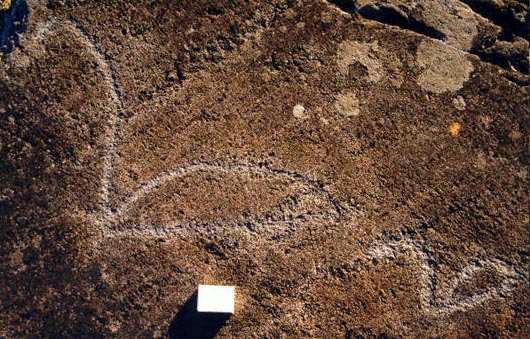

 All petroglyphs in Karelia have been pecked, i.e. engraved into the rock surface by spot strokes of a stone, presumably quartz. The depth of pecking varies from very shallow, superficial impressions to relatively deep, rough ones. The average depth is 2-3 mm. Most figures in the White Sea area have been pecked to cover the whole area of the silhouette while Onega Lake petroglyphs are often made up of the outline only. There are also figures one part of which is performed as an outline, and the other - as a silhouette. The pecking, especially the one covering the whole silhouette, creates a polychromic effect due to the contrast between the natural rock surface and a lighter silhouette colour. Great variations are observed in the distinctness of the contour line which in some cases is very even, while in other cases - "torn". The dominant type is figures shown in profile, but front and plane projections were also used. The engravings are best visible in the oblique rays of the setting or rising sun, which make the figures stand out more clearly. The sizes vary from tiny several-centimeter-long figures to very large 2.5-4.1 m ones. These giant figures are however few in number the dominant size being 15 to 60 cm.
All petroglyphs in Karelia have been pecked, i.e. engraved into the rock surface by spot strokes of a stone, presumably quartz. The depth of pecking varies from very shallow, superficial impressions to relatively deep, rough ones. The average depth is 2-3 mm. Most figures in the White Sea area have been pecked to cover the whole area of the silhouette while Onega Lake petroglyphs are often made up of the outline only. There are also figures one part of which is performed as an outline, and the other - as a silhouette. The pecking, especially the one covering the whole silhouette, creates a polychromic effect due to the contrast between the natural rock surface and a lighter silhouette colour. Great variations are observed in the distinctness of the contour line which in some cases is very even, while in other cases - "torn". The dominant type is figures shown in profile, but front and plane projections were also used. The engravings are best visible in the oblique rays of the setting or rising sun, which make the figures stand out more clearly. The sizes vary from tiny several-centimeter-long figures to very large 2.5-4.1 m ones. These giant figures are however few in number the dominant size being 15 to 60 cm.previous | 0 | 1 | 2 | 3 | 4 | 5 | 6 | 7 | 8 | 9 | 10 | 11 | 12 | next



